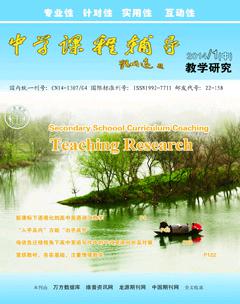主谓一致解题方法综述
王宏宇
摘要:主谓一致是英语语法中比较简单易懂的知识点,是指谓语动词在人称和数上与主语保持一致。本文就这一语法项目从四个方面展开了讨论,以便让学生更好地记忆。
关键词:英语语法;主谓一致;解题方法
中图分类号:G632.0 文献标识码:A 文章编号:1992-7711(2014)01-0119
一、用单数的情况
1. 有些集体名词(总称意义的),谓语动词用单数。
furniture, clothing, jewellery, luggage, machinery, pottery
eg: Much of the jewellery was missing.
2. 名词所有格后的名词常被省,指工厂、人家、店铺等,谓语动词用单数。
eg: The barbers/My uncles is on the other side of the street.
3. to do, doing作主语,谓语动词用单数。
eg: To help you is my pleasure.
4.合成代词some/any/no/every+thing/body/one作主语及each, every one, no one, either, neither, another, the other作主及either/neither/each/every/many a/more than one+名作主,谓语动词用单数。(none 单复数均可)
eg: More than one student has seen the film.
eg: Many a ship has been damaged in the storm.
5. 由连接的两个单数名词作主语,若名词前有each, every, no, many a 修饰,谓语动词用单数。
eg: No teacher and no student is here.
6. 表时间、距离、金钱、重量、度量衡等的数词作主语,谓语动词用单数。
eg: Five minutes is enough.
eg: Ten dollars is too dear.
但如强调数量,谓语动词用复。eg: One hundred cents are a dollar.
二、用复数的情况
1. people, police, cattle, folk, youth等作主语,谓语动词用复数。
eg: The police were searching for him.
2. trousers, glasses, shoes, clothes, shorts, scissors, jeans, compasses, chopsticks谓语动词用复数(但若前有单位词,由单位词定)
eg: These trousers are made in China.
eg: This pair of trousers is made in China.
三、单复数视情况而定
1. 集体名词作为一个整体看待,谓语用单;作为成员,谓语用复。常见的集体名词有:enemy, family, public, class, team, school, club, army, government, group, audience, company, committee, crowd, crew, couple, jury, party, population, union
eg: Our class is a united one, and our class are football lovers.
eg: The population of China is large and 80 of the population of China are farmers.
2. 单复数同形的名词作主,谓语动词根据意义而定,常见的名词有:deer, fish, sheep, means, species, series, works, crossroads, fishes
eg: The species of fish are numerous.
eg: This species of rose is strange.
3. 复数名词用作专有名词、书名、剧名、报刊名、国家名等作主,谓语动词用单数;但山脉、群岛、瀑布、海峡的名词,谓语用复数。
eg: The New York Times sells well.
eg: The United States was founded in 1776.
eg: The Philipines lie to the southeast of China.
4. 以S结尾的表学科的单数名词,谓语用单;若学科名词前有the/ones,表某人在某学科能力成绩方面存在问题,谓语用单数。
eg: Physics is a different subject.
eg: His physics are weak.
5. the+adj 表一类人,谓语用复;表一类物,谓语用单。
eg: The old are well looked after.
eg: The new will replace the old.
eg: The young standing at the door is my brother.
6. 分数、百分数及the rest, some, most, half, any, part, all, the remainder, plenty of, enough+of+名语作主,谓语根据名语数而定。
eg: A part of the land is devoted to agriculture.
eg: A part of the fields are watered.
eg: All were silent. 大家都一言不发。
eg: All was silent. 万籁俱寂。
7. 主语后有with, along with, together with, as well as, but, except, besides, like, rather than, including, combined with, accompanied by, in addition to, no less than等词时,谓语与主语一致。
eg: The father, rather than the brothers, is responsible.
eg: He no less than you is wrong.
8. and 连接两个名词表同一个人或物,谓语用单;指不同人或物,谓语用复。
eg: The writer and poet has been there.
eg: The writer and the poet have been there.
eg: Truth and honesty is the best policy.
eg: War and peace is a constant theme in history.
9. what 引导主语从句,谓语常用单数;但若从句的宾语或表语是复数,谓语用复数。
eg: What you said is right.
eg: What we need is a good book./ What we need are good books.
10. 由kind, form, type, sort, species, series, quantity of +名词作主,谓语动词取决于这些词的单复数。
eg: This kind of men is honest. / All kinds of books are good.
eg: Men of this kind are honest.
11. 定语从句的先行词前有one of 时,定语从句中谓语动词看先行词;若有the only修饰,从句谓动词用单数。
eg: He is one of the students who study hard.
eg: He is the only one of the students who studies hard.
12. such, the same, the former, the latter, the following 等视其指代内容而定。
eg: Such is our plan.
eg: Such are his books.
eg: Of pigs and cows, the former are less valuable.
四、就近一致原则
1. or, either...or , neither...nor, not only...but also, not...but连接两个名词或代词作主语,谓语就近一致。
2. There, Here 引导的句子。
eg: There are two books.
eg: Here comes the bus.
eg: There is a book and two knives on the desk.
注意: One and a half+名词复数,谓单
More than one+名词单数,谓单
Many a+名词单数,谓单
One or two+名词复数,谓复
以上的分类解释比较清楚明了,笔者希望对认为此处比较难理解的学生会有所帮助,以取得更好的成绩。
(作者单位:黑龙江省鸡西市第一中学 158100)

